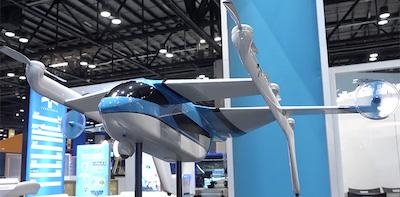Industry Experts Believe That Future Is Closer Than Most Think
Anyone who's ever dreamed of traveling above congested city streets may soon have their dreams realized, and possibly sooner than they may think. Electrically powered, pilotless, vertical takeoff and landing (VTOL) aircraft offer the potential to radically change urban transportation, and an overflow, standing-room-only session at NBAA’s Business Aviation Convention & Exhibition (NBAA-BACE) took a closer look at this promising technology.

One of the most significant revelations to come from the Business Aviation Insider magazine-hosted session, "Imagining the Future of Pilotless VTOL Aircraft," is that the biggest challenge isn't necessarily creating pilotless VTOL vehicles, but creating a safe, reliable and secure infrastructure in which those aircraft will operate in already congested urban airspace.
Development of a real-time, on-demand, global network that not only includes VTOL aircraft, but also airspace considerations, landing pads and crowd control and passenger accommodations is the key priority for Uber Elevate. The rideshare service is working with manufacturers, technology providers and others to bring pilotless VTOL to fruition. Uber Elevate has partnered with five aerospace companies to bring such vehicles to market as soon as 2023, with safety the primary consideration.
"As long as we can make the safety case as our number one priority – whether on the aircraft, operational or airspace side – I think we can get [regulators] to understand that and will be able to work with us," said Kate Fraser, head of aviation policy for the urban mobility enterprise.
The General Aviation Manufacturers Association (GAMA) also reached out several years ago to emerging players in VTOL to aid them in this process, and heed the lessons learned from similar efforts to integrate unmanned aircraft systems (UAS) in manned airspace.
"We'd found is there wasn't a coherent flight path forward of how to get [UAS] into the airspace," recalled GAMA president and CEO Pete Bunce, who moderated Wednesday's panel. "We wanted to prevent that [with urban VTOL] so we could start working together for the good of all."
Bruce Holmes, vice president for digital aviation at SmartSky Networks, said bandwidth is the most important factor toward enabling a truly autonomous urban VTOL system. Current 4G networks lack the capacity to handle such complication processes, though emerging 5G systems offer hope.
"The concept that is evolving and makes the most sense is not separating aircraft, but separating flight paths in future time," he said. "We need the ability to manage flight paths, other traffic, exclusions and atmospherics, and we need to have a connectivity solution that enables us to do it.
"Picture how the NAS and all its users operate today, largely offline," Holmes continued. "Now picture how you work in your business; you probably couldn't do it offline. What would it look like to have a NAS and all its users, all air traffic management functions and airports, online, everywhere?"
EmbraerX president and CEO Antonio Campello pointed to difficulties with integrating autonomous ground-based vehicles, but noted that aircraft present fewer challenges. "It's actually easier for an aircraft to become fully autonomous because there are fewer variables involved," he said. "New technologies are already here; it's not that those need to be developed. What's missing for autonomous vehicles is sense-and-avoid capability able to deviate [for unexpected situations] and we need to develop those solutions."
Carl Dietrich, cofounder and chief technology officer for Terrafugia, said one potential approach for managing the safe integration of pilotless VTOL is through utilizing simplified vehicle operations technologies that automate certain processes in piloting a manned aircraft.
"This allows us to go to flight standards folks and say, 'what if we were to certify a vehicle with these functions, which meet the certification requirements just for those functions?'" he said. "Could we then be allowed to not train a new pilot for those tasks? That's the new idea we're trying to get buy-in for."
As the industry looks toward resolving these challenges, Fraser said it's important that all stakeholders work together towards their common goal of safe, reliable and profitable VTOL operations.
"There's a lot we can do together," she said. "Partnership is key here, even with our competitors, because we're all new in this airspace. How can we collaboratively look at how to address our roadblocks? It's a unique opportunity to work together."
(Image provided with NBAA news release)
 ANN's Daily Aero-Term (05.10.24): Takeoff Roll
ANN's Daily Aero-Term (05.10.24): Takeoff Roll Aero-News: Quote of the Day (05.10.24)
Aero-News: Quote of the Day (05.10.24) Aero-News: Quote of the Day (05.11.24)
Aero-News: Quote of the Day (05.11.24) ANN's Daily Aero-Term (05.11.24): IDENT Feature
ANN's Daily Aero-Term (05.11.24): IDENT Feature ANN's Daily Aero-Linx (05.11.24)
ANN's Daily Aero-Linx (05.11.24)



